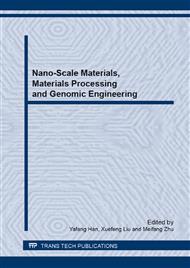[1]
Peng, Y.F., Sheng, Z. X., Zhang, H., and Fan, X.W. Influence of thermal deformations of the output windows of high-power laser systems in beam characteristics. Applied Optics. 43 (2004) 6465-6472.
DOI: 10.1364/ao.43.006465
Google Scholar
[2]
D. B. Tuckerman, and R. F. W. Pease. High-Performance Heat Sinking for VLSI. IEEE Electron Device Letters. 2(1981) 126-129.
DOI: 10.1109/edl.1981.25367
Google Scholar
[3]
S. Ashman, S. Kandlikar, A review of manufacturing processes for microchannel heat exchanger fabrication. Fourth International Conference on Nanochannels, Microchannels and Minichannels, ICNMM96121(2006).
DOI: 10.1115/icnmm2006-96121
Google Scholar
[4]
Zhu, H.H., Lu, L., Fuh, J.Y.H., Development and characterisation of direct laser sintering Cu-based metal powder. Journal of Materials Processing Technology. 140(2003) 314-317.
DOI: 10.1016/s0924-0136(03)00755-6
Google Scholar
[5]
Wang, F., Mei, J., Wu, XH. Direct laser fabrication of Ti6Al4V/TiB. Journal of Materials Processing Technology. 195(2008) 321-326.
DOI: 10.1016/j.jmatprotec.2007.05.024
Google Scholar
[6]
Simchi A, Pohl H. Direct laser sintering of iron-graphite powder mixture. Materials Science and Engineering A. 383(2004) 191-200.
DOI: 10.1016/j.msea.2004.05.070
Google Scholar
[7]
Xie, J.W., Fox, P., O'Neill, W., Sutcliffe, C., Effect of direct laser re-melting processing parameters and scanning strategies on the densification of tool steels. Journal of Materials Processing Technology. 170(2005) 516-523.
DOI: 10.1016/j.jmatprotec.2005.05.055
Google Scholar
[8]
M. Erdal, Serkan Dag, Y. Jande, C.M. Tekin, Manufacturing of functionally graded porous products by selective laser sintering. Materials Science Forum. 631(2010) 253-258.
DOI: 10.4028/www.scientific.net/msf.631-632.253
Google Scholar
[9]
V. V. Apollonov, A. I. Barchukov, V. I. Borodin, P. I. Bystrov, V. F. Goncharov, Possibility of using structures with open pores in construction of cooled laser mirrors. Soviet Journal of Quantum Electronics. 8(1978) 672-673.
DOI: 10.1070/qe1978v008n05abeh010371
Google Scholar
[10]
V. V. Apollonov, S. Derzhavin, V. Kuzminov, D. Mashkovskiy, V. Timoshkin, and V. Philonenko, Intensification of heat transfer in high-power laser diode bars by means of porous metal heat-sink. Optical Express. 4(1999) 27-32.
DOI: 10.1364/oe.4.000027
Google Scholar
[11]
Andrei A. Istratova, and Eicke R. Weber, Physics of Copper in Silicon. Journal of The Electrochemical Society. 149(2002) 21-30.
Google Scholar
[12]
J. G. M. Becht, F. J. J. van Loo, and R. Metselaar, The influence of phosphorus on the solid state reaction between copper and silicon. React. Solids. 6(1988) 45-49.
DOI: 10.1016/0168-7336(88)80045-7
Google Scholar


